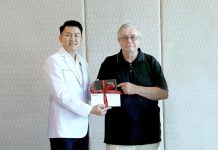We are still getting increasing inpatient numbers at the hospital of patients with Dengue Fever, including the dangerous Dengue Hemorrhagic Fever (DHF). With the rain we are getting every afternoon at present, there is plenty of standing water for the mosquito host to breed in. Dengue Fever is another of those viral illnesses, and we have no direct answer to the virus. There is no “antibiotic” for the Dengue virus.
Like Malaria, the virus is carried by mosquitoes, this time by one called Aedes aegypti. The virus itself is related to Japanese encephalitis, Murray Valley encephalitis and Yellow fever, and there are four “serotypes” or subgroups of it.
Perusal of the news all over Thailand shows that Dengue fever is on the up and up. In fact, in the North, the incidence of Dengue Hemorrhagic Fever has tripled compared to previous years. Even on our tourist islands this has become a problem, and on some of the surrounding islands as well. We have not been singled out by the virus, by the way, as it is spreading through the USA. However, with the monsoon rains we have been having recently, this is one of the reasons that this disease is on the upsurge in this country – but there is something we can all do about it. Read on!
However, first you should understand a little more about Dengue. This is a nasty viral condition that has been coming round in epidemic waves for many years. It is also a fairly wide spread virus with 2.5 billion people living in Dengue endemic areas. We, in Thailand, belong to that group. That is a very large number of people who can contract this illness.
The mosquito lays its eggs in standing water (and there is plenty left each evening after the afternoon showers), preferring the clean water found in water tanks and pots, in the saucers under pot plants and even under the pet’s food dish. Inside discarded car tyres are another favorite spot. These mosquitoes are not of the adventurous type and feed during the day and spend their time within 200 meters of their hatchery. Consequently, the eradication of any local breeding areas becomes very important towards maintaining your own health, as you can see. Keep your home free from lying water for a radius of 200 meters and you’re looking good!
Simple Dengue (if you can call it that) has an incubation period of around 4 to 7 days and then the full blown symptoms of high fever and headache begin. The headache is usually behind the eyes and is made worse by eye movement. From there the pains progress to the limbs with acute muscle pains, which gave it the old name “Break Bone Fever”. Interestingly, some patients complain of a metallic taste in the mouth. (Please don’t ask – I have no idea why!)
With our ability to treat the viral ailments being very limited, the defense against the Dengue virus lies in Health and Hygiene initiatives, to stop you getting mosquitoes in the house during the day. For example, do you regularly change the water in containers the Aedes aegypti mosquito might call home? Do you have mosquito screens? Does baby sleep under a mosquito net? If the answer to these questions is “no”, then perhaps it is time to look critically at your own Dengue prevention plan. Let me assure you, it is not a disease you want! And the Hemorrhagic form in particular can be lethal.
The other precautions are to wear long trousers and long sleeved shirts, especially at sun up and sun down, when the mosquito is at its most ravenous.
The other factor to remember is “D” for Dengue and “D” for DEET. DEET is the magic ingredient in mosquito repellents, so when you go to buy some repellent, check the label – if it has DEET, then get it. And then remember to use it!
So to avoid falling prey to Aedes aegypti, empty free standing water around the home, use screens and mosquito nets if necessary and apply repellent containing DEET. Best of luck!




